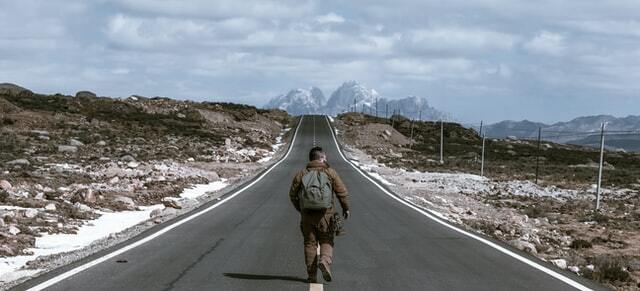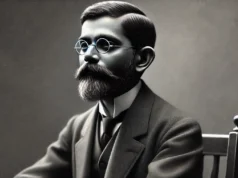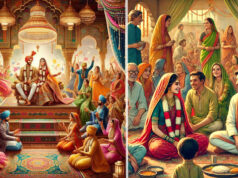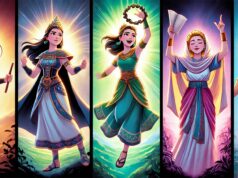
The Book of Ruth reminds us human life travels from sorrow to satisfaction, from tears to rejoicing, from bitterness to blessedness, from emptiness to fullness, from darkness to light, from chains and bondage and sin to liberty and freedom and covenant. Have you made that journey?
The Old Testament tells us of how God prepared the world for the coming of the Messiah, the Lord Jesus Christ. His life, death and resurrection were explained both by Jesus himself and by the apostles in Old Testament terms, and with Old Testament motifs. It is possible to begin with the Books of Moses, and to work through the prophetic literature and the rest of the Old Testament writings, and to find Christ there (cf. Luke 24:27; John 5:39).
The Book of Ruth bears witness to the love of God which ultimately would show itself in the coming of Jesus Christ, the Son of David. Indeed, the Book of Ruth teaches us not only that God loves a lost and sinful world, but that he opens up doors of remarkable blessing through his redemptive love. It is a theme that is consonant with the whole message of the Old Testament.
Thus while the narrative of the Book of Ruth is full of interest as a powerful story of choice, of love, and of blessing, its deeper meaning is to be found at the level of what biblical scholars call the ‘metanarrative’ — the big story — of the Bible. For at last, there is only one Gospel, and one covenant of grace.
And sinners are saved because God is still looking for a wife for Abraham’s great Son, the Lord Jesus. They are saved because the law has made provision for redemption through kinship, and there is one whose work is sufficient to bring us into the bond of the covenant. They are saved because David’s greater Son, the Lord Jesus Christ, loved his church and gave himself for it.
The love stories of the Old Testament, understood against the backdrop of the covenantal unity of the Bible, point forward to the marriage of the Lamb.
This little book of Ruth is sandwiched between the Book of Judges on the one hand, and the First Book of Samuel on the other, two momentous books that remind us of the many varied and difficult experiences of the people of God in the Old Testament.
And it shines out on the pages of the Old Testament like a light in the darkness, like a bright star in the night sky. It is, to my mind, one of the most moving and one of the most beautiful books of the Bible; and as we study this book of Ruth together I hope that we will see that its significance is out of all proportion to its length.
You will know that there are two books in the Old Testament that are named after women. One is the book of Ruth, and the other, of course, is the Book of Esther. Both of them are very, very different. Esther was a queen. Ruth was a very lowly peasant girl. Esther was a Jewess who married a Gentile. Ruth was a Gentile who married a Jew.
The Book of Esther opens with a feast, while the Book of Ruth opens with a famine. The Book of Esther comes to a close with the hanging of an enemy; the Book of Ruth comes to a close with the birth of a child.
But both of these books, for all of their differences, are concerned with one issue, and that is the issue of God’s preserving His own church in the world. There are times in the history of the world and in the history of the church when we are tempted to think that the church has no future, and that the cause of the church is doomed to extinction.
Many think that the work and witness of the church are no longer relevant, and that it is a dying institution. But I think that it is important to come to these great books of the Old Testament, particularly this Book of Ruth, to remind ourselves that the church can never be a dying institution because she is the preserve of God. She is under the direct supervision of God, who has pledged himself to the maintenance of His own cause, and to the furtherance of his own Gospel.
God has promised that people will be blessed in and through the saving work of Christ, and the Book of Ruth reminds us that however low the cause of Truth might come before the eyes of men, before the eyes of God it is marching forward in triumphal procession, gathering momentum and blessing and changing the lives of men and women and children along the way.
The Book of Ruth reminds us that to the uttermost the God who preserves his own church and his own cause in the world will change people and bring them into what the prophet Ezekiel called “the bond of his own covenant”.
If we are to spend some time gleaning around the chapters of the Book of Ruth, then we need to understand something of the setting and the meaning and the themes that are covered in this great book of four chapters that we have in the Old Testament. It is important, I think, to take an overview of this great Book of Ruth, and to look at the movement there is over its chapters and across its pages and its verses.
I’m afraid sometimes that men and women have a view of God that he is some kind of static, unmoving entity in the sky, whereas what we discover in the Bible is that the God in the Bible is a God of movement, a God who changes the lives of men and women and who makes the most fundamental and the most radical difference in the heart and the home of an individual. Just as he made a difference to Ruth, he can make a difference to us.
To summarise the difference God makes, I want to borrow Warren Wiersbe’s summary of the four chapters of the Book of Ruth. The first chapter of the Book of Ruth, is a chapter full of tears: it’s a weeping chapter.
It’s a chapter of sorrow. We see Naomi weeping. We see Orpah weeping. We see Ruth weeping. There are all these tears, so many broken hearts; and yet that is the introduction for this great book of the Old Testament — this weeping chapter filled with sorrow.
And then we come into Chapter Two, the great working chapter, the chapter in which Ruth finds herself among the workers and among the people of Boaz, gleaning in his fields at the beginning of Bethlehem harvest.
It’s a chapter of service, a chapter in which Ruth is engaged in a great work that is full of spiritual significance and full of spiritual lessons and encouragement for her and for us.
And then we come into Chapter Three where we find Ruth waiting. She has got to be patient. She has to go to a certain place at a certain time and she has to wait for Boaz, and she has to wait on Boaz and she has to wait until Boaz can deal with and regulate all the affairs that concern her personally now that she’s come as a stranger among God’s people.
It’s a chapter full of submission in which Ruth bows before the Lord God, and before the person of Boaz, her kinsman redeemer, in which she waits, and her waiting is not in vain. It’s the kind of waiting that David has described in Psalm 40 when he says, “I waited for the Lord my God, and he heard my cry, and he lifted me out of the pit.”
And then Chapter Four is the great wedding chapter, the great marriage, the final consummation of God’s purposes for Ruth the Moabitess. She is joined in marriage to Boaz and a child is born. There, in the marriage of Ruth and Boaz there is great satisfaction that the purposes and the promises and the blessing of God have been enjoyed and experienced.
So, in the course of this narrative, we move from sorrow through service and submission to satisfaction. And that is precisely the movement of the Gospel from beginning to end; the Gospel that comes to us in a world of sin and of sorrow, a world of broken hearts and broken dreams and broken promises and broken lives.
And the Gospel that finds us in the midst of all this trouble and sorrow and heartache brings us at last to the place of submission before Christ and satisfaction in Christ. If we have not experienced that great movement of the Grace of God in our soul then we have missed the greatest thing in the world.
Because until Jesus Christ fills the void in the heart of people, there will always be sorrow and there will always be heartache, there will always be meaningless and futility, and men will always wake up and say “What is it all for?”
The world will continue to deceive and delude, to promise and to renege. Without a relationship with Jesus Christ, people will chase their dreams and pursue their plans down every road and every avenue of human experience and they will always return saying, “I did not find it there.
I went down this road looking for it, looking for peace and meaning and satisfaction, looking for purpose, and at the end of it there was brokenness — there were broken plans and broken dreams and it did not work and I left that place hopeless and more desperate than ever before.
And then I went down this road and that road and the next road and every other road and I was chasing the wind”. The Bible says that the man who “chases the wind” will “reap the whirlwind”.
Isaiah described the Saviour as ‘the shadow of a great rock in a weary land’ (Isaiah 32:2). Here is this great image of people living in the wilderness, open to all the problems of the wilderness: the sun beating mercilessly and the drought and the dryness and the barren desert all around them.
All they want is some shelter, some rock, some shadow from the sun, something to keep them and to preserve them; to take away the burning, burning heat of the sun and the dryness and the barrenness of the desert and the meaninglessness of it all.
God says there is a man, the God-man, who is like a hiding place in the storm, the shadow of a great rock in our weary life. To come to him is to experience the transition from emptiness to fullness, despair to rejoicing.
And that is exactly the movement and message of the Book of Ruth. It is possible for a human life to travel from sorrow to satisfaction, from tears to rejoicing, from bitterness to blessedness, from emptiness to fullness, from darkness to light, from chains and bondage and sin to liberty and freedom and covenant. Have you made that journey?
Photo by David Marcu on Unsplash









